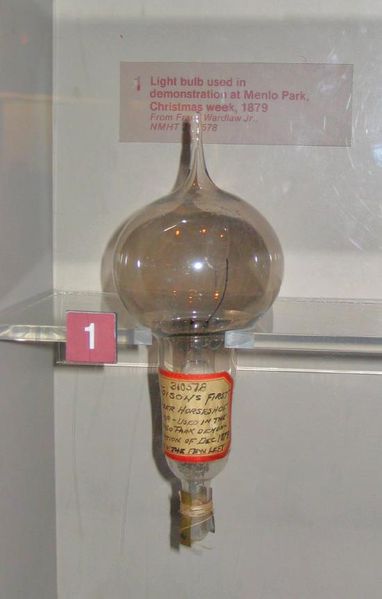The Perfection of the Light Bulb
In 1875 Herman Sprengel invented the mercury vacuum pump making it possible to develop a practical electric light bulb by making a really good vacuum inside the bulb possible. In 1878 Sir Joseph Wilson Swan, an English physicist, was the first person to invent a practical and longer-lasting electric light bulb (13.5 hours). Swan used a carbon fiber filament derived from cotton. Many others contributed to the development of the light bulb during the years. It Is clear that Tomas Alva Edison could not be credited with the invention of the electric light bulb (incandescent lamp). Nevertheless, his contribution to the perfection of this device is really impressing. Until 1878 when Edison decided to throw the bulk of his attention and resources into the perfection of the light bulb the best source of lighting was gas. Unfortunately it was far from convenient. It was dirty, unhealthy, uncomfortable and dangerous. When gas burned it created soot everywhere. It degraded the air quality by emitting soot and depleting oxygen. During the summer it made the air even hotter and more uncomfortable. It caused explosions, fires and its care could not be trusted to children. But the major deficit of gas was that it could not serve as a source of power. The appliances we take for granted today - fans, refrigerators, electric irons and computers - could not be powered by gas, at least not in a convenient way. On the other hand, light bulbs existing prior to Edison’s efforts burned for a short time – the best achievement was Swan’s, 13.5 hours, though a great breakthrough, not commercially yet. Thomas Alva Edison, a prolific inventor, and his team (yes, he did not work alone!) experimented with thousands of different filaments to find just the right materials to glow well and be long-lasting. In 1879 Edison obtained an improved Sprengel vacuum pump, and it proved to be the catalyst for a breakthrough. Edison discovered that a carbon filament in an oxygen-free bulb glowed for 40 hours. Soon, by changing the shape of the filament to a horseshoe it burned for over 100 hours and later, by additional improvements, it lasted for 1500 hours. Edison and his colleagues had invented a practical light bulb and by doing so they opened up the way for the establishment of the electrical power system. It was this power system that became Edison's real achievement. It beget a huge new industry that would radically effect everyone. By September of 1882 he had opened a central station on Pearl Street in Manhattan and was eventually supplying electricity to a one mile square section of New York. It’s important to mention that Edison's method for generating and transmitting electricity employed direct current (DC) whereas modern power stations employ alternating current (AC ) introduced by George Westinghouse based on Nikola Tesla, and others’, patents. Nevertheless, this and other obstacles, Edison’s power station is regarded by many as the first practical power station ever because the Pearl Street station provided reliable central power generation, safe and efficient distribution, and a successful end use - Edison’s long-lasting incandescent light bulb - at a price that competed successfully with gas lighting. ResourcesWho Invented the Lightbulb? - The Museum of Unnatural MysteryThe Invention of the Light Bulb: Davy, Swan and Edison - EnchantedLearning.com Fascinating Facts about the Invention of the Light Bulb - The Great Idea Finder Pearl Street Station: The Dawn of Commercial Electric Power - IEEEVM History of the Electric Power Industry - Edison Electric Institute The History of the Incandescent Lightbulb - about.com Thomas Edison - Wikipedia Make Your Own Light Bulb
To create a vacuum use a vacuum pump or let a candle burn inside the closed jar till it goes out and oxygen is consummated. Repeat your experiment with or without vacuum or oxygen in the closed jar. Record the burning time of the differnt filaments and conditions by a clock and the glowing power by a photometer. Safety Hints: This experiment needs to be done with an adult present and supervising it! Be careful handling the filaments when they burn out - they will be hot! For more details about this experiment try the following links (from the easy to the more difficult): Make a Light Bulb - Smithsonian Who Turned on the Lights? - The Charles Edison Fund Construction of the Edison Bulb - Raymond Rogers, Mike Shaffer Incandescent Light Bulbs - How Things Work? How Light Bulbs Work - howstuffworks The Physics and Materials of the Incandescent Light Bulb - Science Education Foundation The Great Internet Light Bulb Book - Donald L. Klipstein Edison's Filament Innovations General Edison Resources What Did Thomas Alva Edison Invent? Edison National Historic Site The Edison Papers - Rutgers Tomas A. Edison and the Menlo Park Laboratory - The Henry Ford The Charles Edison Fund Edison After Forty - Smithsonian Edison: His Life and Inventions - a 1929 book by Dyer and Martin Thomas Edison's Home Page Edison Frequently Asked Questions - Edison National Historic Site Bulb & Lamp Science Fair Projects and Experiments |
| Home | Fair Projects | Experiments |
| Scientists & Inventors | Science Jokes | Warning! |





webmaster@julianTrubin.com

